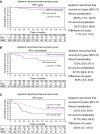Postoperative wound complications and systemic recurrence in breast cancer
- PMID: 17968426
- PMCID: PMC2360477
- DOI: 10.1038/sj.bjc.6604004
Postoperative wound complications and systemic recurrence in breast cancer
Abstract
Many factors involved in wound healing can stimulate tumour growth in the experimental setting. This study examined the relationship between wound complications and the development of systemic recurrence after treatment of primary breast cancer. One thousand and sixty-five patients diagnosed with operable primary invasive breast cancer between 1994 and 2001 were assessed for development of systemic recurrence according to whether or not a wound complication occurred after surgery, with a median follow-up of 54 months (range 15-119). There were 93 wound complications (9%). There was a statistically significant greater risk of developing systemic recurrence in patients with wound problems than those without (hazard ratio (HR) 2.87; 95% CI: 1.97, 4.18; P<0.0001). This remained in a multivariate analysis after adjustment for case mix variables, including Nottingham Prognostic Index (NPI) and oestrogen-progesterone receptor status (HR: 2.52; 95% CI: 1.69, 3.77; P<0.0001). In the good prognostic NPI group, 4 out of 27 patients (15%) with wound problems vs 11 out of 334 (3%) without wound problems developed systemic recurrence. The corresponding figures were 10 out of 35 (29%) vs 48 out of 412 (12 %) in the moderate prognostic group and 18 out of 29 (62%) vs 75 out of 199 (38%) in the poor prognostic group. In 29 patients NPI could not be calculated. Smokers at the time of diagnosis were more likely to develop metastatic disease than the non-smokers (HR: 1.50; 95% CI: 1.04, 2.15; P=0.03) after adjustment for other factors. The results suggest that patients with wound complications at primary surgery have increased rates of systemic recurrence of breast cancer.
Figures


Similar articles
-
Influence of complications following immediate breast reconstruction on breast cancer recurrence rates.Br J Surg. 2016 Mar;103(4):391-8. doi: 10.1002/bjs.10068. Br J Surg. 2016. PMID: 26891211
-
Evaluation of long-term outcome following therapeutic mammaplasty: the effect of wound complication on initiation of adjuvant therapy and subsequent oncological outcome.Ann R Coll Surg Engl. 2025 Feb;107(2):112-118. doi: 10.1308/rcsann.2023.0095. Epub 2024 May 15. Ann R Coll Surg Engl. 2025. PMID: 38746984 Free PMC article.
-
Comparison of ipsilateral breast tumor recurrence after breast-conserving surgery between ductal carcinoma in situ and invasive breast cancer.World J Surg Oncol. 2016 Apr 27;14:126. doi: 10.1186/s12957-016-0885-6. World J Surg Oncol. 2016. PMID: 27122132 Free PMC article.
-
Significance of multifocality in ductal carcinoma in situ: outcomes of women treated with breast-conserving therapy.J Clin Oncol. 2007 Dec 10;25(35):5591-6. doi: 10.1200/JCO.2007.11.4686. Epub 2007 Nov 5. J Clin Oncol. 2007. PMID: 17984188
-
The effect of postoperative complications on survival and recurrence after surgery for breast cancer: A systematic review and meta-analysis.Crit Rev Oncol Hematol. 2020 Nov;155:103075. doi: 10.1016/j.critrevonc.2020.103075. Epub 2020 Aug 18. Crit Rev Oncol Hematol. 2020. PMID: 32987333
Cited by
-
Use of gentamicin-collagen sponge (Collatamp® G) in minimally invasive colorectal cancer surgery: A propensity score-matched study.PLoS One. 2022 Mar 28;17(3):e0264513. doi: 10.1371/journal.pone.0264513. eCollection 2022. PLoS One. 2022. PMID: 35344540 Free PMC article.
-
The occurrence of high-grade complications after radical cystectomy worsens oncological outcomes in patients with bladder cancer.Int Urol Nephrol. 2020 Mar;52(3):475-480. doi: 10.1007/s11255-019-02341-9. Epub 2019 Nov 22. Int Urol Nephrol. 2020. PMID: 31758383
-
Association Between Anesthesia Delivered During Tumor Resection and Cancer Survival: a Systematic Review of a Mixed Picture with Constant Themes.J Gastrointest Surg. 2021 Aug;25(8):2129-2141. doi: 10.1007/s11605-021-05037-7. Epub 2021 Jun 7. J Gastrointest Surg. 2021. PMID: 34100251 Free PMC article.
-
Hydroxyl safflower yellow B combined with doxorubicin inhibits the proliferation of human breast cancer MCF-7 cells.Oncol Lett. 2021 May;21(5):426. doi: 10.3892/ol.2021.12687. Epub 2021 Mar 29. Oncol Lett. 2021. PMID: 33850567 Free PMC article.
-
Personalised cancer follow-up: risk stratification, needs assessment or both?Br J Cancer. 2012 Jan 3;106(1):1-5. doi: 10.1038/bjc.2011.535. Br J Cancer. 2012. PMID: 22215103 Free PMC article. No abstract available.
References
-
- Balkwill F, Mantovani A (2001) Inflammation and cancer: back to Virchow? Lancet 357: 539–545 - PubMed
-
- Chang HY, Nuyten DS, Sneddon JB, Hastie T, Tibshirani R, Sorlie T, Dai H, He YD, Van’t Veer LJ, Bartelink H, Van de Rijn M, Brown PO, Van de Vijver MJ (2005) Robustness, scalability, and integration of wound-response gene expression signature in predicting breast cancer survival. Proc Natl Acad Sci USA 102: 3738–3743 - PMC - PubMed
-
- Coffey JC, Wang JH, Smith MJF, Bouchier-Hayes D, Cotter TG, Redmond HP (2003) Excisional surgery for cancer cure: therapy at a cost. Lancet Oncol 4: 760–768 - PubMed
Publication types
MeSH terms
LinkOut - more resources
Full Text Sources
Medical
Research Materials

